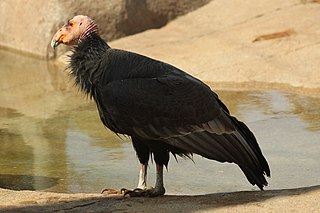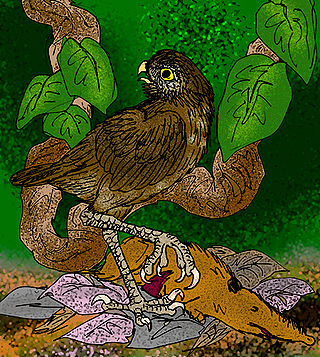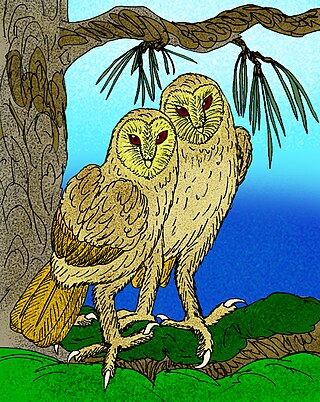Related Research Articles

Gymnogyps is a genus of New World vultures in the family Cathartidae. There are five known species in the genus, with only one being extant, the California condor.

The Cuban giant owl or giant cursorial owl (Ornimegalonyx) is an extinct genus of giant owl that measured 1.1 metres in height. It is closely related to the many species of living owls of the genus Strix. It was a flightless or nearly flightless bird and it is believed to be the largest owl that ever existed. It lived on the island of Cuba.

Tyto pollens is an extinct giant barn owl which lived in the Bahamas during the last Ice Age.

The genus Cathartes includes medium-sized to large carrion-feeding birds in the New World vulture (Cathartidae) family. The three extant species currently classified in this genus occur widely in the Americas. There is one extinct species known from the Quaternary of Cuba.
Buteogallus borrasi is a species of giant buteonine hawk which went extinct in the early Holocene. Formerly endemic to Cuba, this huge bird of prey probably fed on Pleistocene megafauna. Little is known about its appearance and ecology, so no common name has been given.
Paleontology or palaeontology is the study of prehistoric life forms on Earth through the examination of plant and animal fossils. This includes the study of body fossils, tracks (ichnites), burrows, cast-off parts, fossilised feces (coprolites), palynomorphs and chemical residues. Because humans have encountered fossils for millennia, paleontology has a long history both before and after becoming formalized as a science. This article records significant discoveries and events related to paleontology that occurred or were published in the year 2002.
Paleontology or palaeontology is the study of prehistoric life forms on Earth through the examination of plant and animal fossils. This includes the study of body fossils, tracks (ichnites), burrows, cast-off parts, fossilised feces (coprolites), palynomorphs and chemical residues. Because humans have encountered fossils for millennia, paleontology has a long history both before and after becoming formalized as a science. This article records significant discoveries and events related to paleontology that occurred or were published in the year 1985.
Paleontology or palaeontology is the study of prehistoric life forms on Earth through the examination of plant and animal fossils. This includes the study of body fossils, tracks (ichnites), burrows, cast-off parts, fossilised feces (coprolites), palynomorphs and chemical residues. Because humans have encountered fossils for millennia, paleontology has a long history both before and after becoming formalized as a science. This article records significant discoveries and events related to paleontology that occurred or were published in the year 1984.
Paleontology or palaeontology is the study of prehistoric life forms on Earth through the examination of plant and animal fossils. This includes the study of body fossils, tracks (ichnites), burrows, cast-off parts, fossilised feces (coprolites), palynomorphs and chemical residues. Because humans have encountered fossils for millennia, paleontology has a long history both before and after becoming formalized as a science. This article records significant discoveries and events related to paleontology that occurred or were published in the year 1981.
Paleontology or palaeontology is the study of prehistoric life forms on Earth through the examination of plant and animal fossils. This includes the study of body fossils, tracks (ichnites), burrows, cast-off parts, fossilised feces (coprolites), palynomorphs and chemical residues. Because humans have encountered fossils for millennia, paleontology has a long history both before and after becoming formalized as a science. This article records significant discoveries and events related to paleontology that occurred or were published in the year 1972.
Paleontology or palaeontology is the study of prehistoric life forms on Earth through the examination of plant and animal fossils. This includes the study of body fossils, tracks (ichnites), burrows, cast-off parts, fossilised feces (coprolites), palynomorphs and chemical residues. Because humans have encountered fossils for millennia, paleontology has a long history both before and after becoming formalized as a science. This article records significant discoveries and events related to paleontology that occurred or were published in the year 1971.

The Jamaican ibis, Jamaican flightless ibis or clubbed-wing ibis is an extinct bird species of the ibis subfamily uniquely characterized by its club-like wings. It is the only species in the genus Xenicibis, and one of only two flightless ibis genera, the other being the genus Apteribis which was endemic to Hawaii's islands of Maui Nui.
Oscaravis olsoni, of the teratorn family, was a large, predatory bird that roamed the territory that is now modern-day Cuba before going extinct at the end of the Pleistocene era. Previously classified as Teratornis olsoni, it has recently been granted a new genus due to its ecological isolation from others in the teratorn family, as well as differences in size and possibly behavior. Although no exact measurements can be stated, due to recent archaeological findings and the comparison of O. olsoni bone lengths with that of other teratorns, it has been concluded Oscaravis olsoni would have had a body bigger than Taubatornis campbelli but smaller than Cathartornis gracilis.
Gymnogyps varonai, sometimes called the Cuban condor, is an extinct species of large New World vulture in the family Cathartidae. G. varonai is related to the living California condor, G. californianus and the extinct G. kofordi, either one of which it may have evolved from. The species is solely known from fossils found in the Late Pleistocene to Early Holocene tar seep deposits in Cuba. G. varonai may have preyed upon carcasses from large mammals such as ground sloths.
Bubo osvaldoi, also known as the Cuban horned owl, is an extinct species of horned owl from Pleistocene of Cuba.

Rivero's barn owl is an extinct species of barn owl that was very large — bigger than any extant barn owl species, and possibly larger than any known owl alive today. It is thought to have been nearly as large as another extinct gigantic owl, Ornimegalonyx. Suárez and Olson demoted T. riveroi as a junior synonym of Tyto pollens in 2015.
The Cuban kestrel was a species of small falcon in the family Falconidae that was formerly endemic to the island of Cuba. It was described from fossil remains from late Quaternary deposits from several sites throughout the island.
Emslie's vulture is an extinct species of vulture in the family Cathartidae. It is only known from a series of fossils found in western Cuba. The fossils were primarily found in caves or Quaternary asphault deposits. It is significantly smaller than the extant C. aura. It likely became extinct during the Holocene following the extinction of Cuban Pleistocene megafauna whose bodies it would have fed on, coupled with the loss of the open savannas it would have inhabited.
Gigantohierax is a genus of eagle from the Quaternary of present-day Cuba. Little is known about the two known species of the genus other than their very large size.
References
- ↑ Suarez, William; Olson, Storrs L. (2009). "A new genus for the Cuban teratorn (Aves: Teratornithidae)" (PDF). Proceedings of the Biological Society of Washington. 122 (1): 103–116. doi:10.2988/08-27.1. S2CID 86566584.
- 1 2 Wiley, James (2007). "Obituary Oscar Arredondo (1918–2001)" (PDF). Ornitologia Neotropical (in Spanish). 18: 149–154.
- ↑ Suarez, William (2001). "A Reevaluation of Some Fossils Identified as Vultures (Aves: Vulturidae) from Quaternary Cave Deposits of Cuba" (PDF). Caribbean Journal of Science. 37 (1–2): 110–111.
- ↑ Arredondo, Oscar. "The Great Predatory Birds of the Pleistocene of Cuba". In Olson, Storrs L. (ed.). Collected Papers in Avian Paleontology Honoring the 90th Birthday of Alexander Wetmore. Smithsonian Museum. pp. 169–187. hdl:10088/19094?show=full.